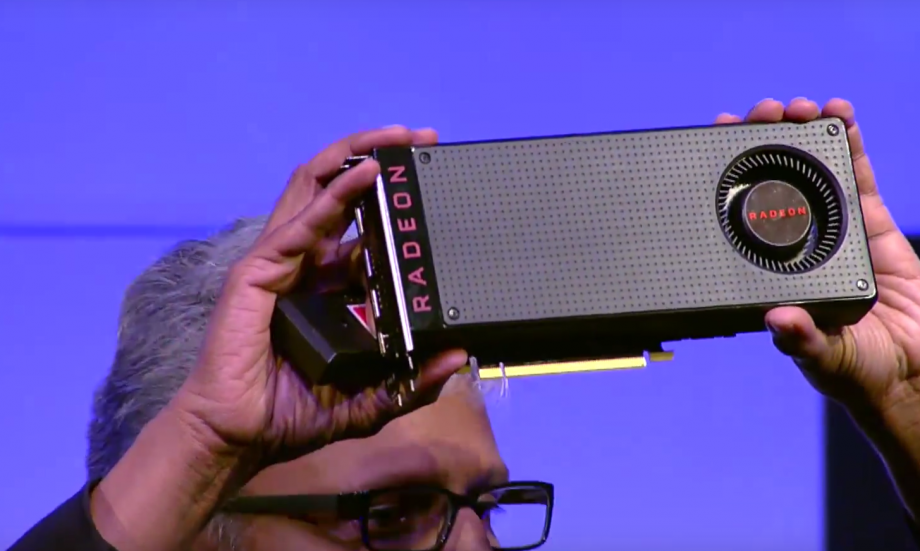Is the AMD RX 480 the Moto G of graphics cards?

OPINION Is AMD’s new graphics card a serious contender? Reviews Editor Alastair Stevenson certainly thinks so.
Nvidia’s on a hot streak this year. The GTX 1080, the year’s most anticipated graphics card, is the new performance benchmark and the 1070 is no slouch either.
But, given AMD’s stellar work investing in the new Vulkan API and its excellent 2015 portfolio, I had an inkling that the 1080’s time in the sun would be short lived.
That’s why my initial reaction to AMD’s freshly unveiled, ultra-affordable Radeon RX 480 was less than positive – the words “what the [censored]”, may have been uttered more than once.
However, having had time to reflect, I’ve warmed to the 480. In fact, it could become the Moto G of graphics cards – a card that redefines what ‘good value’ is.
Radeon RX 480: Super-cheap and VR-ready
The Radeon RX 480, according to AMD, will run VR games despite costing a piddly $200 – roughly £160 before VAT in the UK.
This is a big deal. Prior to now, the Oculus Rift and HTC Vive’s hefty system requirements have limited their audience. The need for PCs to be able to play VR games at 90fps has been a particular challenge that means you have to invest in a decent GPU, like Nvidia’s £250 GTX 970, to run either headset comfortably, albeit at their low settings.
The low starting price is important, as it means the RX 480 targets a segment of the PC market where Nvidia has nothing to offer – at least until it launches a new wave of mid-range 10XX-series GPUs.
It could also be a stimulus that increases overall interest in the Vive and Oculus Rift, though pricing for the headsets will still leave both firmly as enthusiast items.
Video: HTC Vive vs Oculus Rift
Low price, top specs
AMD’s yet to offer a full specifications list for the GPU, but from what we know so far it comes loaded with the some impressive hardware and could be a valid competitor to the GTX 1070 – a card expected to cost £400. That’s roughly twice the price the RX 480 will retail for in the UK.
The RX 480 has 36 compute units (CUs) – the building blocks that give any GPU its computational power. The number is a step up from AMD’s older R9 380, which had 28, and just four short of the company’s £300 R9 390.
It’ll also come with 4GB and 8GB GDDR5 options – which puts it roughly on par with the more expensive Nvidia GTX 1070 when it comes to memory – and will run AMD’s much-hyped Polaris architecture.
Polaris is AMD’s answer to Nvidia’s Pascal; it aims to improve a GPU’s performance, stability and cooling efficiency.
Could it beat a GTX 1080 in Crossfire?
AMD’s performance claims aren’t limited to VR or the Nvidia GTX 1070.
All this sounds like hot-air marketing, but AMD has offered some proof to back its claim. AMD raced a rig with two 480s running in CrossFire against a 1080-powered computer at the GPU’s unveiling. The CrossFire rig played strategy game Ashes of the Singularity at 62.5fps, while the Nvidia GeForce GTX 1080 ran the title at 58.7fps.
The performance difference may sound small, but when you consider the fact that two 480s are still cheaper than a single Nvidia 1080, it’s still a pretty impressive achievement.
Related: Best Graphics Card 2016
But you should still wait for our review…
All this sounds great, but before you hit the “shut up and take my money” phase, I’d take a minute to breathe. Sure, AMD’s claims sound impressive, and if even a portion of them ring true the 480 will offer excellent value for money. However, there are a few key details that leave me nervous.
For starters the game used during the demo is known to favour AMD components. This is because Ashes of the Singularity is optimised with DirectX 12 and supports asynchronous compute – a bit of technology currently absent on Nvidia GPUs.
Async compute is a nifty bit of tech that lets a GPU work on graphics and computing tasks simultaneously. This lets the 480 complete jobs faster by removing the need for the GPU to wait for one job to be finished before starting another on titles that are optimised for the tech.
This makes the performance claim slightly questionable, as there are currently very few games optimised for multi-GPU setups – though this may change if the shiny new Vulkan and DirectX 12 APIs get mainstream support from developers.
Related: Best Gaming PC – Build your own PC guide
AMD also kept quiet about the fact that running two 480s will double the GPU’s power requirements from 150W to 300W and require a fairly expensive motherboard that’s compatible with CrossFire.
Running two 480s in CrossFire will also impact VR performance, as most of the engines used in virtual reality games don’t feature CrossFire or SLI support. Both Valve and Oculus have warned that multi-GPU rigs will be more prone to crashing and black screens of death.
None of these are deal-breakers, and the 480 definitely has potential, but they are questions that need to be answered before we can definitively give the GPU our badge of approval.
Video: Nvidia GTX 1080 review
Fortunately, with review samples expected shortly, we won’t have to wait long to get our answers and I can’t help but get excited about AMD’s new GPU.
Stay tuned to TrustedReviews for a full review of the AMD Radeon RX 480 and leave any questions you have in the comments section below.


